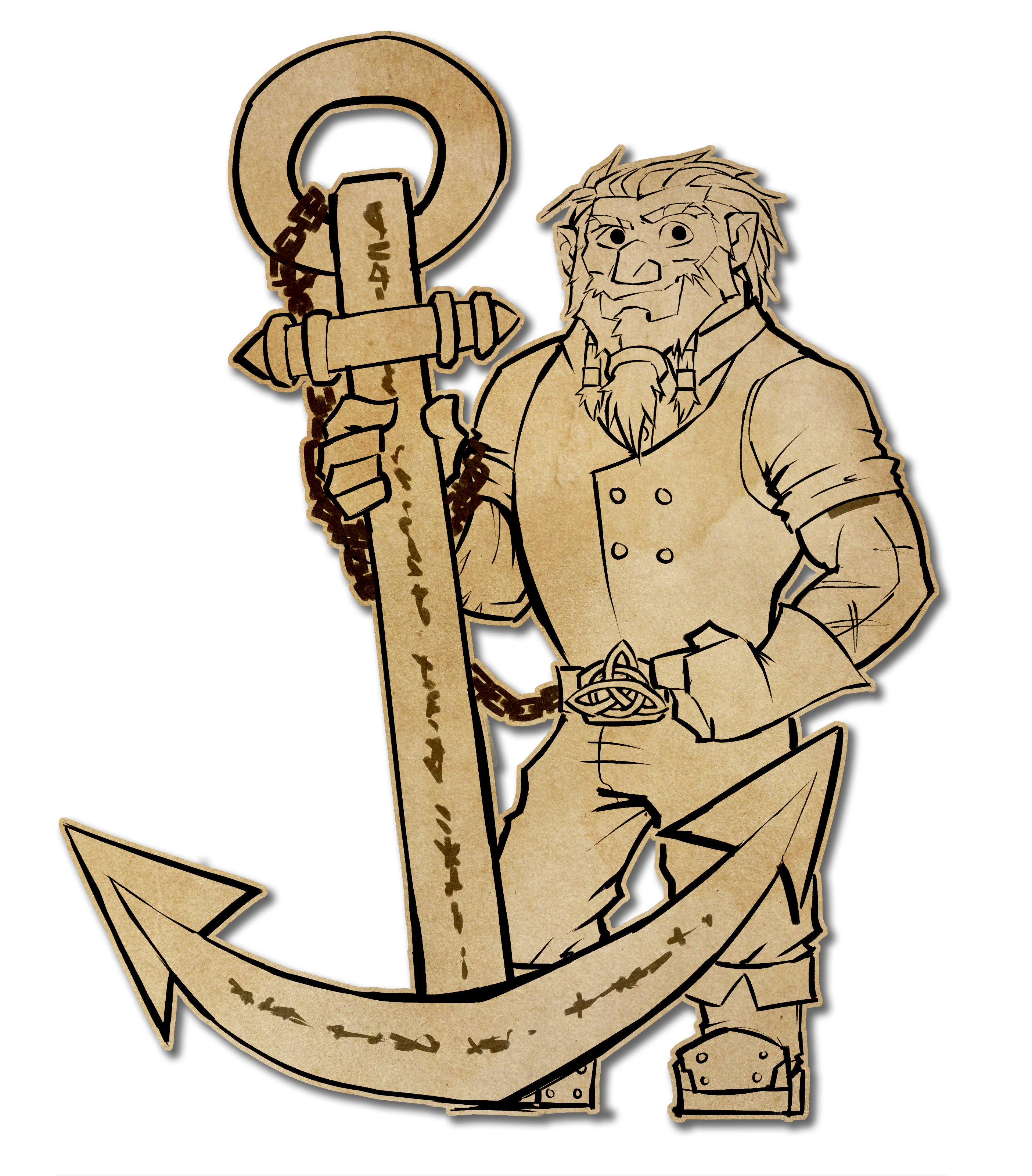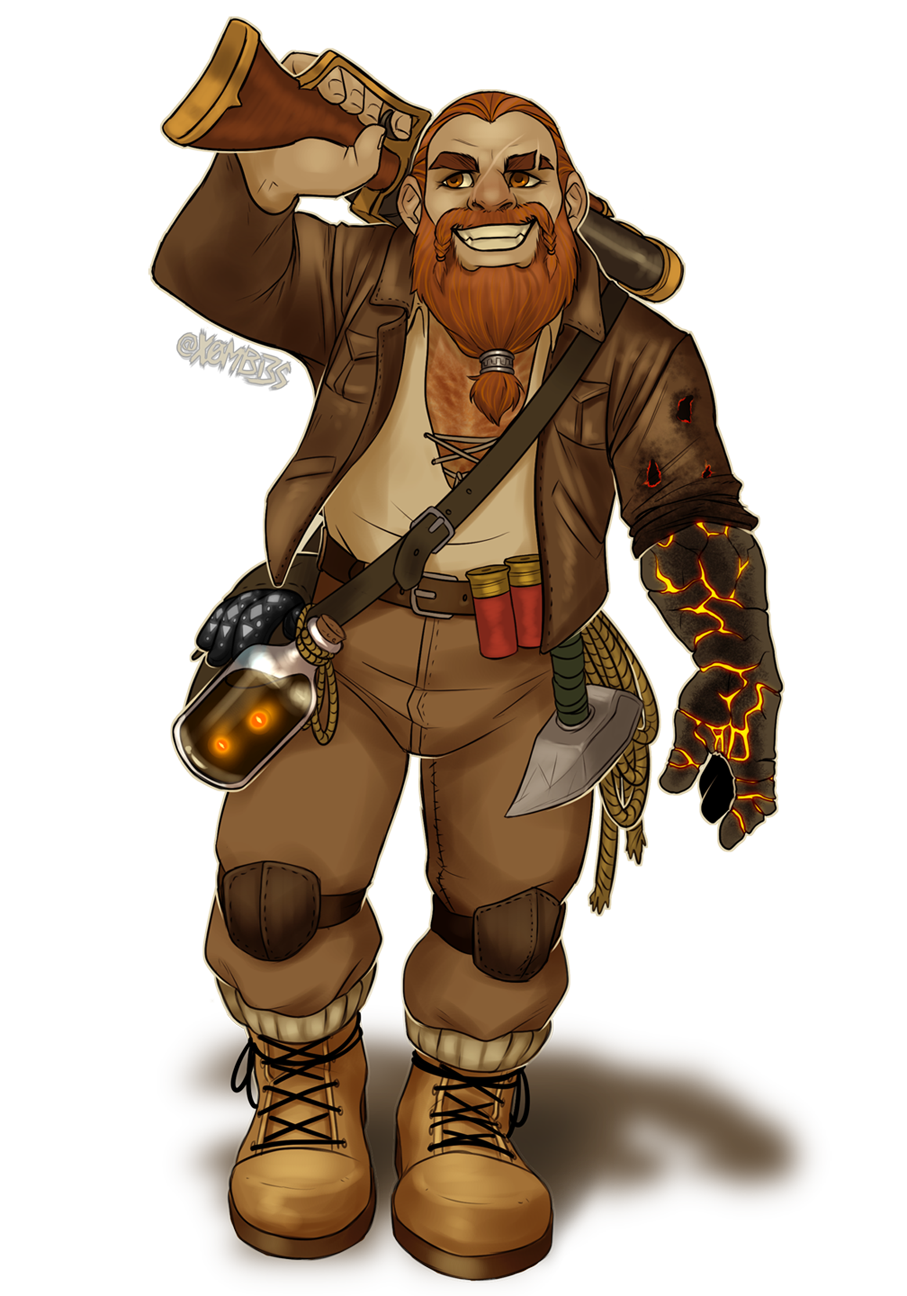Dwarves
If you want something done cheap, and you don't mind getting what you pay for, you go to the humans. You want something done properly, and you don't mind drowning in red tape along the way, ask the qoatl. But if you just bloody well want something done for Mordy's sake, you come to us.
The dwarves are one of the dominant species on the mountainous continent of Mordrekain, making up one half of its primary ruling body, as well as the only major nation-state, Ár Fearann; the Underkingdom. Alongside the gnomes, their once neighbors turned mortal foes become brothers and sisters in arms, they've forged a mighty empire within the very heart of the land, boring expansive cities and untold kilometers of tunnel under and across nearly half of the landmass.
Although specializations differ with region and upbringing, the dwarves have always been a people of progress and industry, feeling profoundly uncomfortable in situations of stillness and stagnation. Their almost preternatural hardiness has seen them through many periods of explosive development over the centuries - increasingly literally in recent years - and even the worst of setbacks has done little to lessen their resolve to leave their mark on the world. Quite a few marks, in fact. Generally, as many marks as it is physically and philosophically possible for them to make.
Basic Information
Anatomy
Dwarves are short, stocky individuals, usually within in and around a meter in height and sometimes not too far off of that in breadth. Other than their stature, the only other outward trait they have that differentiates them from the typical humanoid model is an inordinate amount of hair. Dwarven beards are legendary in size and scope - although trimming them shorter has been a fashion trend across a few different decades in their timeline - and the hair across the rest of their head and body is similarly hearty. It also happens to have a particular wiriness to it that gives it nearly as much value as a form of defense from bumps, scrapes, and animal attacks as it is from the chilly temperatures of their subterranean homeland.

Brádach MacNamara, Dwarven Folk Hero by Retro Hurricane
Biological Traits
Rather than a full mouth of teeth, dwarves grow solid tooth-plates across the entirety of their upper and lower jaws. Used in ancient times to scrape lichens from stones and meat from bones, they continuously regrow over time to account for the mass they lose from use. In more modern times, when prepared and grown foods replace scavenging, these plates are generally filed down instead, with some dwarves who live amongst humans opting to file slight grooves into them to emulate distinct teeth. According to many, humans are made uncomfortable by their natural, smooth smiles.
Due to crossbreeding with gnomes here and there over the years, some dwarven family lines have been noted to have naturally sharper edges to their tooth-plates, and in some cases have been known to grow distinct canine teeth, giving them an almost fanged appearance.
Additional Information
Facial characteristics
Dwarves are typically described as having rather blocky faces, as humanoids go - though they might instead use the term 'chiseled'. Their jawlines are universally quite squared off and paired with quite wide chins. Their brow lines and noses are similarly large, though the latter can sometimes have a touch of an upward point to them if they have any gnomish blood in their family tree.
As mentioned before, nearly all dwarves are naturally hairy beings. That said, males have a tendency towards partial or complete baldness as they age, and it's not uncommon to see some with especially high hairlines even in their younger days, but the folically-challenged often make up for this by having intensely bushy eyebrows and facial hair. Women usually don't grow beard hair - though it's not an entirely unknown phenomenon - but will still have quite long sideburns which they often braid or clip together in similar ways.
Perception and Sensory Capabilities
As is common among cave-dwellers, dwarves have much stronger senses of touch, smell, and hearing than they do of sight, but although this translates into a slightly weakened perception of color compared to some other folk, the vision they do have in low-light conditions is quite strong. Additionally, there is some speculation that dwarves may have an extra sense in the form of an innate sense of direction and place. Their balance organs are hyper-sensitive, allowing them to note even minor shifts in incline or altitude, and they naturally memorize spaces quite well. Combined with their hearing, this lends dwarves a natural aptitude for learning means of echolocation, though even with their advantages it is not an inherent trait of their kind and can take quite a while to master.
Civilization and Culture
Naming Traditions
Names among dwarves tend not to be the most creative of things. Their given names tend to be evocative nouns or concepts in the old tongue that their culture currently holds or previously held in high regard. Clan and family names, by a similar token, are generally more descriptive than anything, describing places of origin, particularly noteworthy ancestors, or historical events they were involved with.
Beauty Ideals

Flint "Blast" O'Hammond, Dwarven Adventurer by Sophie "x0mbi3s" Jameson
With hair being such a prominent feature among the dwarves, and their men in particular, it's no wonder it also features prominently in what they typically find attractive. Most important of all elements of a dwarf's hair is that it's properly wrangled. Whether through braids or clips or rings or ties, hair that's allowed to run wild gives the impression that its wearer is careless, lazy, or simply dirty. In modern times, shorter styles have once again come into fashion, with particularly large beards or braids to the mid-back being seen as somewhat old-fashioned, not to mention being health hazards in the growing age of machines.
Average Technological Level
The dwarves have thrown themselves into the industrial age with gusto, automating just about anything they possibly can, and building complex machinery in attempts to make more 'convenient' the things they can't. Calling them one of the most technologically advanced nations in the world is arguable, but they certainly have the thickest density of technology. Of particular note, they have a fondness for combustion engines and black-powder devices, utilizing both equally between their constant mining efforts and the steadily subsiding threat of warfare from outsiders. Their skills in various kinds of carving and engraving have also lent them a great advantage in modern runeworking methods, allowing them to augment much of their technology with magic.
Major Language Groups and Dialects
Though the traditional languages of the Dwarves and the Gnomes are still used by many families and in most traditional ceremonies, the Qoatl Tradespeech project quickly became the de facto 'official language' of the Underkingdom, both because of its convenience for an empire of their size, and because many of its foundations borrowed heavily from their languages and from their close Human neighbors. In Gnomish families in particular, children are often taught the 'mother tongue' first, then transitioned quickly into Tradespeech, leaning on its structural similarities to make it easier to pick up.
Culture and Cultural Heritage
Writ large, the dwarves are a culture of craftsfolk, builders, explorers, and inventors. These are the noblest of pursuits, to most minds, and everyone is expected to dabble in at least one or two of them. In the past, these pursuits were largely focused towards expansion and conquest, particularly after the ousting of the Gnomes from the Old Underkingdom, but in recent centuries focus has shifted towards the betterment of the quality of life, discovery for the sake of it, and general, loosely-defined 'Progress'.
Common Customs, Traditions and Rituals
There are three criteria for your First Work: One, it does what you made it for. Two, it advanced your understanding of a field. Three, it looks damn good on your mantle. Aim for all of them, expect to settle for two.
Upon coming of age in dwarven society, a youth is expected to begin tinkering with something that will become their First Work. That is, a personal project they feel passionate about that will prove not only their skills in a chosen field, but their value to the Underkingdom as a whole. Exactly what this Work is expected to be has shifted over the years. In more ancient times, it was often a tool or weapon, and as is to be expected these remain popular choices into the modern day. However, as life and knowledge have steadily improved, the spread of acceptable outputs has grown tremendously. Scientific studies, especially in medicine, will often be deemed worthy of the title of First Work, provided the youth undertaking them at least bettered themselves in their undertaking. Even art has been counted a number of times in recent decades, though these cases are still saddled with a fair amount of stigma from those who deem it to be a less practical pursuit.
Historical Figures
Áed an Casúr, the First Underking and founder of Vulkenesburgh - Long believed to have been marked by Vulkram himself, it is said that Áed excavated the entirety of the city's original cavern in one single blow with his divine hammer.
Brádach MacNamara - A veritable giant by dwarven standards, MacNamara struck out into the world to become a sailor with human vessels when working alongside their kind was still unheard of. Along the way, he acquired an enchanted anchor that became his trademark tool, drank a minimum of three gods under the table, and once attempted to pull the world back together on an expedition to Malephesh's Tear.
Flint "Blast" O'Hammond - Son of explorer and cartographer Gavin O'Hammond, with whom he disappeared on the slopes of Mount Hold's Bane. Flint returned years later, Marked and with little information to offer about the circumstances of the crash, but eager to continue his father's work.
Genetic Descendants
Lifespan
~100 Years
Average Height
1.2 - 1.6 m
Average Physique
Stocky, dense, short; otherwise highly variable
Body Tint, Colouring and Marking
Primarily earthen tones, ranging from grays to browns to reds. Families that have rarely ventured outside of the Underkingdom will often be pale, those who have ventured out elsewhere into the world will have darker shades depending on where they went.
Related Ethnicities




Comments